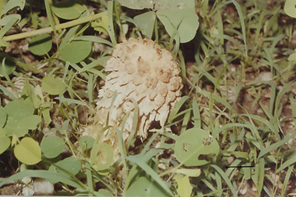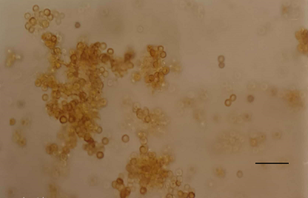Phellorinia herculeana subsp. strobilina (Kalchbr.,) Dring & Rayss, Israel J. Bot.12:176(1964) Fig. 3
MycoBank number: MB 349974; Index Fungorum number: IF 349974;Facesoffungi number: FoF 09747;
Fruiting body – 9–12 cm high, creamish-white, stipitate, coarsely scaly, typically shaped like a wine glass. Stipe – solid and woody, the base of the stipe typically enlarged into a hardened mass of soil and mycelium resembling a sclerotium and sometimes giving rise to two or three fruiting bodies. Peridium – coarsely scaly with large imbricate scales that persist longer where the stipe expands to form the spore case. Endoperidium – thin and finally breaking up across the flattened apical surface to expose the rusty–cinnamon gleba. Gleba – rusty–cinnamon, capitilial threads thick-walled, pale ochraceous, rarely septate. Spores– 5–7 × 4.5–6.0 µm, globose to sub – globose, finely verrucose.
Ecology and distribution –Phellorinia herculeana subsp. strobilina has been reported on dry sandy soil in arid and semi-arid areas by Dring (1964) and Dring& Rayner (1967) from Africa and Zimbabwe by Sharp &Piearce (1999).
Specimens examined – JNV/Mycl/140 on 28 July 2017 in zone II B of survey area by Charu Panwar growing in soil amongst grasses. 26°16’6.28″N73°00’21.38″E Jodhpur, elevation:231 m (758 ft), 25°20’44.09″N72°36’56.12″E Jalore, elevation:178 m(584 ft),25°46’12.00″N73°19’48.00″E Pali, 24°53’18.17″N72°50′ 52.58″E Sirohi, elevation:321 m (1,053 ft).
Note –Phellorinia herculeana subsp. strobilina differs from P. herculeana subsp. herculeana in possessing large, thick, pyramidal, coarse, persistent scales of the exoperidium that are larger and more prominently developed in the apical portion. Gleba and spores are the same as in P. herculeana subsp. herculeana. Specimens attained a length of 18–20 cm, with a stipe that is 6–7 cm thick in diameter.P. herculeana has been reported by Sharma et al. (2015) to be from Jaisalmer, Rajasthan but P.herculeana subsp. strobilina is a newly recorded species for India.

a

b
Fig. 3–a Fruiting body of Phellorinia herculeana subsp. strobilina growing on grassy habitats in natural conditions. b Spores. Scale bar: a = 5 cm,b = 20 µm.
